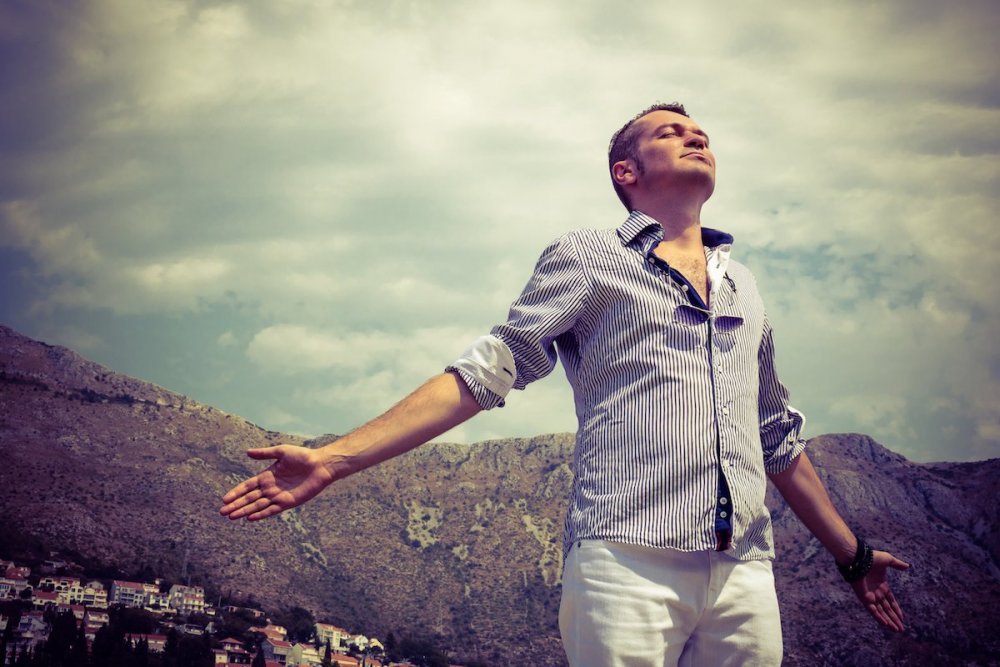Breathing is essential and something we do without thinking. But a new book suggests that we should pay it more attention as we can use the power of the breath to heal emotional and physical symptoms. Jacqui Paterson digs deeper.
Breathing. It’s the most natural thing in the world, right?
Controlled by the medulla oblongata – one of the most primitive parts of our brain – that automatically starts the moment we enter the world and take our first tremulous, wailing breaths.
We rarely pay attention to this essential biological process where, very simplistically, air is pulled into the lungs, where oxygen is extracted and dispersed around our body, and the waste product – carbon dioxide – is exhaled out.
In fact, probably the only time many of us really think about breathing is when we’re having trouble doing so –when we’re puffed from exerting ourselves, or when panic attacks cause us to hyperventilate.
But, perhaps, we should be a lot more conscious of the healing power of the breath on a day-to-day basis.
That’s because when we don’t give our breathing enough focus, it defaults to its basic auto-pilot function. Yes, it’s enough to keep us alive, but it’s usually shallow and erratic and doesn’t allow us access to the huge array of additional healing benefits breathing can provide.
The healing power of the breath
In fact, abdominal breathing techniques have been used for centuries, especially through the practise of yoga. Indeed, so-called breathwork makes up a huge component of this ancient Indian practice, which unites mind, breath and body to improve fitness, health and well-being.
RELATED: Conscious Breathing: What Is It and How Do We Benefit From It?
But, in fact, there are so many ways breathwork can be used to our benefit. Our breath is an endless resource we can call on at any time; a fact well known to psychotherapist and breathwork expert, Oliver James, who has used breathing techniques to totally transform his life.

Can we use our breath to heal? shutterstock/LumineImages
Five years ago, at the tail-end of his psychotherapy training, James came to the realisation that breathing wasn’t just an unconscious reflex, but something that united every living person on the planet. He devoted the next year to studying breathing techniques, soaking up all the published works he could find, but also exploring, reflecting and experimenting with his own breath.
What he discovered was there was a style of breath to lessen or relieve multiple situations, from cravings and insomnia, to public speaking and nausea. This realisation changed his life, and compelled him to share what he’d learned in his book, 21 Breaths (Breathing Techniques to Change Your Life).
There is a breath for everything, he states confidently.
Before you dismiss the words as a bit ‘out there’, James backs it up with biological fact, explaining how each of the individual parts and systems of our body rely on breathing and the absorption of oxygen, and how we can improve each function simply by making our intake of air more purposeful and efficient.
RELATED: Tummo Breathing and Meditation: a Guide
Think of it like putting fuel in a car – the basic version will allow it to run, but the enhanced version helps it run more smoothly and efficiently and will better protect all the components of the engine. Breathwork works in the same way – except the engine is your body.
How to breathe properly
James starts by asking a simple question – are we breathing properly?
The best way is to use the diaphragm, a muscle that separates the chest from the stomach, for abdominal breathing. According to the British Lung Foundation, this is the main breathing muscle and works by contracting when you breathe in, pulling the lungs downwards, stretching and expanding them. When you breathe out, it relaxes back into a dome shape, and helps push the carbon-dioxide heavy waste air out.
“We should be a lot more conscious of the healing power of the breath on a day-to-day basis. That’s because when we don’t give our breathing enough focus, it defaults to its basic auto-pilot function.”
Your stomach muscles also come into play while exercising, pushing air out of the lungs in a process called forced expiration, AKA the heavy breathing that happens when you exert yourself! Finally, there are also muscles between the ribs that also assist breathing, the intercostal muscles.
When they all work together, the gas exchange process (converting oxygen into carbon dioxide) works smoothly to keep our bodies fit and healthy.
However, modern life is more sedentary than ever, with many of us sat working at a desk and failing to move around much during the day. This means we often default to chest breathing, where we’re only using the upper chest muscles to activate our lungs. Obviously, this is adequate at keeping us alive, but activating the chest muscles – more typically used when we exercise or during emergency situations – can make the body tense up. Then we take rapid, shallow breaths, which can increase feelings of anxiety.
From here, the chain of events continues – if your body detects a stress response, it can activate your fight-or-flight, quickening your pulse and giving you a burst of adrenalin. If it continues to gather pace, it can develop into a panic attack.
RELATED: How To Help Someone Having a Panic Attack: 7 Key Tips
James has a simple test to find out whether you’re relying on chest or abdominal breathing – lie flat on the ground with your knees bent and lay one hand on your chest and the other on your stomach. Which hand feels the most movement? This is where you’re breathing from on a daily basis.

Breathing exercises can help with emotional and physical health
So, your first task is to ensure you’re breathing smoothly and deeply from your diaphragm. Breathing is something we do without thinking, but abdominal breathing requires us to override that basic functional breath and consciously work to improve its quality. In time, you can reset your body and the better quality breathing will be your norm.
From here, you can begin to explore James' 21 Breaths and discovering the healing power of breath.
Breathing exercises you can try
Here are four of the 21 healing breath techniques from James' book you can practise.
1. 'The Rising Tide': for insomnia
After this last year of fear and uncertainty it’s hardly surprising insomnia has been on the rise; arguably one of the most helpful breaths James suggests is the ‘Rising Tide’ – the Breath to Sleep.
- Lying on your back with your eyes closed and breathe deeply into your lower belly.
- Hold your breath and tense your entire body until you feel the need to exhale.
- The next inhale is longer and slower until it reaches to your collarbones, then imagine it going further up into your skull. Again, squeeze your entire body and hold the breath, then allow all the tension to drain from your body as you exhale.
- After 10 breaths, return to normal; repeat the cycle for a total of three times.
2. 'The Star': for posture
For all those inadvertent home workers who’ve spent the past year hunched over laptops on sofas and kitchen tables, ‘The Star’ – a healing breath to improve posture – is another gem. It uses the breath to concentrate on elongating the spine, creating space between those scrunched up vertebrae and encouraging the shoulders backwards. With consistent practise you can calm your breathing, release muscle tension, and improve your posture.
- Stand with your back against a wall, palms facing outwards.
- Step your feet out around 15cm and make sure your head, shoulders and buttocks are flat against the surface of the wall.
- Inhale and exhale slowly and deeply, using all your abdominal muscles, and feel how the breath lifts and lengthens your spine.
- Pause for a few seconds at the bottom of your breath, and continue pulling up from the head and spine as you press backwards with your head and buttocks. Enjoy that delicious stretch!
3. 'Diaphragmatic Breathing': for heartburn
Acid reflux is a common partner of stress, and can cause a lot of discomfort. If you want to avoid going down the medication route, ‘Diaphragmatic Breathing’ – the Breath for Heartburn, might be your answer.
“Breathing is something we do without thinking, but abdominal breathing requires us to override that basic functional breath and consciously work to improve its quality.”
In 21 Breaths, James points out there are many contributing factors for heartburn, but the right breathing techniques can help to release tension in the diaphragm and calm the digestive system.
- Start by sitting in a comfortable positive, with the knees below the hips.
- With both hands resting on the lower abdomen, shut your eyes and breathe in through the nose and out through the mouth, making sure the breath stays relaxed and effortless.
- Inhale until you can feel your abdomen fill and inflate beneath your hands. Pause for a moment at the top of the breath, then slowly exhale.
- Continue for 15 to 20 minutes. This should be carried out half an hour before eating, or any time you feel that uncomfortable twinge of heartburn.
4. 'The Hum': for public speaking fears
If Zoom calls fill you with dread, ‘The Hum’ – a breath to help public speaking – could be your saviour. Yoga practitioners might find this breath familiar, as it follows a similar principal to Bhramari, or the ‘Bee Breath’; both use the vibrations created by humming to release tension in the body.
- Begin with 10 deep abdominal breaths
- Continue with 10 breaths while humming.
- Close your eyes to concentrate more clearly on all the sensations the sound creates.
- Try stretching your body in different directions during the practise to discover what feels most calming.
At the end of your breathwork you’ll feel more focused and relaxed, and ready to tackle that video conference with confidence!
21 Breaths also features healing breath to calm a nervous flyer, one to increase confidence, one to help lower blood pressure and even a breath that teams with self-reflection to help heal a relationship.
The takeaway: healing power of breath
Breathing is an automatic and essential function but we need to pay more attention to it and its potential to heal or help certain health conditions or situations.
Whatever your ailment, you could have the remedy right under your nose – literally! •
21 Breaths: Breathing Techniques to Change Your Life, by Oliver James, is published by Unify Books.
Main image: shutterstock/fizkes
happiness.com | The fine art of being: learn, practise, share
Are you a happiness.com member? Sign up for free now to enjoy:
■ our happiness magazine with practical life tips
■ share and support others in our happiness forum
■ self-develop with free online classes in our happiness Academy
Written by Jacqui Paterson
 Jacqui has been a true-life and travel journalist for over 25 years and has travelled all over the world telling people's stories. Originally from New Zealand, she's now based in the UK, where she also wrangles two pre-teen daughters, and runs her lifestyle blog, Jacqui Paterson.com
Jacqui has been a true-life and travel journalist for over 25 years and has travelled all over the world telling people's stories. Originally from New Zealand, she's now based in the UK, where she also wrangles two pre-teen daughters, and runs her lifestyle blog, Jacqui Paterson.com





Join the conversation
You are posting as a guest. If you have an account, sign in now to post with your account.
There are no comments to display.